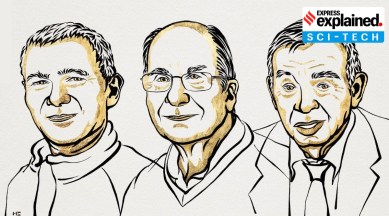Chemistry Nobel 2023: Winners showed how particles’ size changes their behaviour, and why that’s important
About forty years ago, scientists started discovering something very remarkable: very small particles, in the nanoscale range, were found to behave slightly differently from larger particles of the same element. But why was this remarkable, exactly?

Every element exhibits specific properties, usually determined by the number of electrons in its atoms and the distribution of these electrons around the nucleus. Also, every piece of a pure element exhibits exactly the same properties, regardless of its size. A piece of pure gold, for example, has properties very different from a piece of silver or any other element, but every piece of gold, whether it is a large 100-gram piece or a small 10 milligram one, has exactly the same properties. This is one of the fundamental facts of chemistry.
But about forty years ago, scientists started discovering something very remarkable. Very small particles, in the nanoscale range, were found to behave slightly differently from larger particles of the same element. A nanoparticle (sizes in the range of 1 to 100 billionth of a metre) of gold, for example, displayed properties different in some respects from larger particles of gold. Such deviant behaviour had been predicted in theory a few decades earlier, but never observed.
A few years later, Louis Brus, an American scientist working independently, discovered similar behaviour in Cadmium Sulphide nanoparticles. He too was able to create these nanoparticles with changed properties. Moungi Bawendi, who worked with Brus in the initial part of the career, later developed easier methods to efficiently produce nanoparticles that showed some desired deviant behaviour.
For their path-breaking research, done three to four decades ago, Ekimov (78), Brus (80), and Bawendi (62) were awarded the 2023 Nobel Prize in Chemistry. Thanks to their work, nanoparticles with desired deviant behaviour have become an integral part of a variety of modern appliances, including television, computer screens, and LED lamps. There are a wide range of applications in biochemistry and medicine as well.
What are quantum dots?
The deviant behaviour of small nanoparticles arises because of the emergence of quantum effects. The motion and behaviour of very small particles, like electrons, are radically different, and strange, when compared with any familiar object in normal human experience. Such strange behaviour at the sub-atomic level is described by the hugely successful Quantum Theory, developed by physicists 100 years ago.
But nanoparticles are much larger compared with atoms. Depending on the size of the atom, a nanoparticle can pack in thousands to millions of atoms. However, it was theorised, in the 1930s itself, that when the size of particles was reduced to nanoscale, it could give rise to quantum effects.
This was mainly because electrons were constrained in a small space. Usually, electrons move around in a large empty space, relatively speaking, outside the nucleus of the atom. But when the size of the particles is reduced drastically, electrons in the atoms find themselves increasingly squeezed. And this, it was thought, could give rise to the strange quantum effects.
This is what Ekimov and Brus noticed, and this is what they were able to create in their laboratories — nano-sized particles that behaved slightly differently than larger particles of the same element. These nanoparticles with special properties were called quantum dots.
The discoveries
One of the most noticeable special properties of the nanoparticles becomes evident when they interact with light. The colour of any material depends on the wavelengths of the light spectrum absorbed or reflected by the material.
Ekimov was working with coloured glass tinted with Copper Chloride when he noticed something special. He heated molten glass to very high temperatures and then allowed it to cool and harden. Crystals of Copper Chloride, of different sizes, had formed on the glass. He observed that the part of the glass where smaller crystals of Copper Chloride were present had a slightly different colour than the area where there were larger crystals. What this showed was that the same material, Copper Chloride, was absorbing different wavelengths of light depending on its size.
Brus also observed a similar phenomenon, while working on something completely different. He too realised that particles of different sizes, all in the nanometer range, were interacting with light in different ways. This meant that apart from the number of electrons, the properties of the material were also being dictated by its size.
Both Ekimov and Brus could fabricate these nanoparticles, but their methods required extreme conditions and produced particles of unpredictable quality. It was later Bawendi who developed efficient methods to produce nanoparticles with precise desired properties.